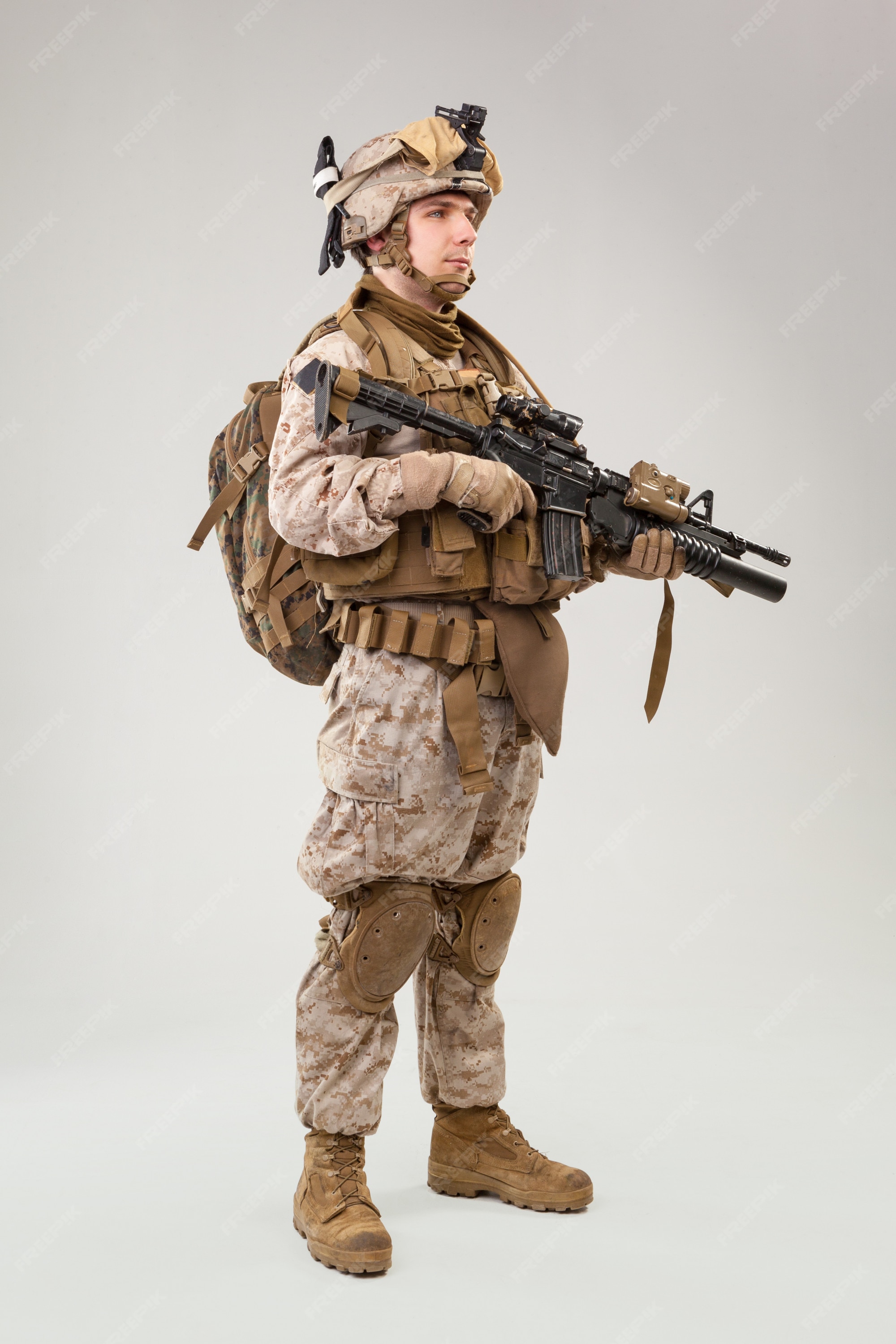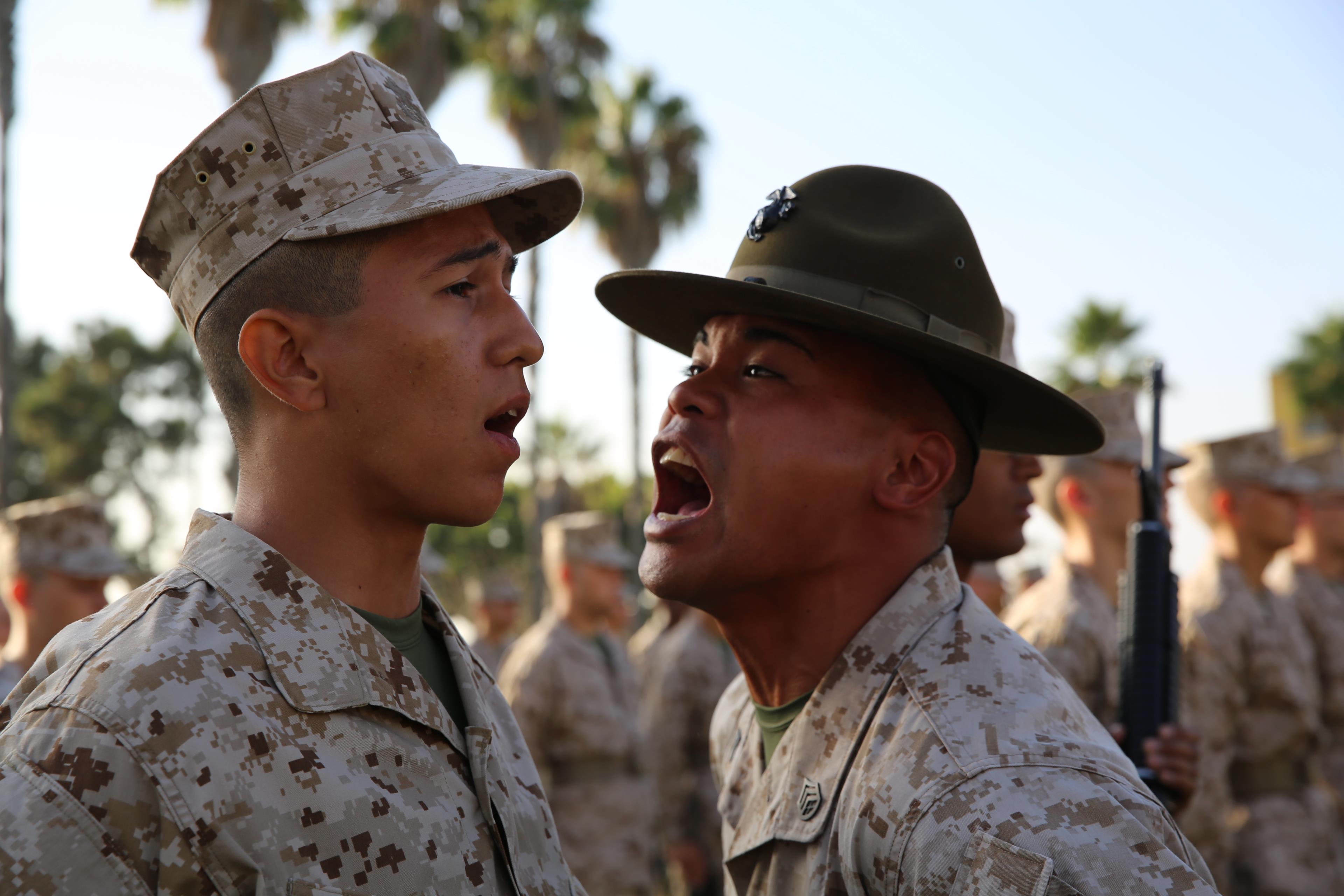Marine Corps Combat Uniform - A 2003 illustration depicting a US Marine wearing the Marine Corps Combat Utility Uniform in desert and jungle camouflage variations.
The Marine Corps Combat Utility Uniform (MCCUU) is the combat uniform of the United States Marine Corps. It is also used by Navy personnel (mainly corpsmen, Seabees, chaplains, and guards) assigned to Marine Corps units (such as the Navy Fleet).
Marine Corps Combat Uniform

This replaces the combat uniform, which the Marine Corps has shared with the Navy, Army and Air Force. However, the MCCUU, and its distinctive camouflage pattern, MARPAT, are unique to the Marine Corps, which retains the patts for its design.
The Corps' New, 'pajama Like' Tropical Uniforms Will Be Available In June
The uniform is available in two color schemes, forest and desert. MCCUU should not be confused with the similar BANGKOK uniform.
MCCUU's first precursor was tested by two US Marines in 2001. Both prototypes feature removable sleeves, a feature that was later left in the finished production version.
MCCUU field trials began in early 2001 and were officially announced to the public in June 2001.
The MCCUU is intended for use in the field or for task forces, but has become the standard work uniform for all deployed sailors and most garrisons of the United States Marine Corps and the US Navy.
File:usmc 101123 M 9453m 913.jpg
At first, different types are used depending on the environment and the season: Marines deployed wear what color is most appropriate to the climate and terrain, Marines in the garrison wear woodland MCCUU during the winter months, and desert MCCUU in the summer months. However, the Marine Corps announced on December 8, 2016 that the desert pattern will no longer be used in the garrison. Instead, woodland MCCUU will be worn all year round, with the sleeves rolled up in the summer and down in the winter.
To the right, the sleeves of the blouse are usually rolled up while in the garrison during the summer months. However, the Uniform Council announced that, from October 24, 2011, this will no longer be allowed. This decision was later reversed when the Commandant of the Marine Corps, General James Amos, announced on February 25, 2014, that the Marine Corps would return to the previous standard of rolling up sleeves while in garrison during the summer months, in force. on March 9, 2014.
Unlike the previous BDU, the MCCUU was designed for use with body armor, which previously limited access to the front pouch. To further distinguish the uniform, on closer inspection, the Eagle, Globe and Anchor can be found in the pattern. Its use as a combat uniform has led to some strict rules for its use in garrisons: Unlike the US Army Combat Uniform (ACU), the MCCUU cannot be removed on base, although it can be worn when traveling and on duty on private property. vehicle. Route detours for casual stops from military installations are no longer permitted except for legitimate emergencies.
Pants are worn on shoes using elastic bands (nickname "boot bands") or metal springs.
File:1stmarinedivision Changeofcommand May2007.jpg
Because of the intense heat in Iraq, vapor wicking t-shirts, such as those produced by Under Armour, became very popular. However, due to concerns that the shirts would melt to the skin in the event of a fire or explosion, they were banned when Sailors were deployed to combat zones.
However, the Marine Corps has teamed up with Danskin to develop its own steam wicking shirt in the "Elite Issue" line,
The MCCUU is used with a web rigger belt earned through the Marine Corps Martial Arts Program. The belt is tan, gray, stud, brown, or up to six degrees of black, depending on Marine ability. Uniform regulations still authorize web belts for use by Marines not qualified in MCMAP; however, the Commandant of the Marine Corps directed in 2008 that all Marines would be eligible. This directive means that items in MCCUU are used for new recruits in basic training or for those who have lost their MCMAP belt because they are not proficient in MCMAP.
Today's Marine Corps needs rugged combat boots, either hot weather or moderate versions. The commercial version of this boot is authorized without restriction except that they must be at least 8 inches high and bear the Eagle, Globe, and Anchor on the outer heel of each boot. Stains and damage to the boot make it unfit to wear, as well as heels and excessive wear.
U.s. Marine Corps Cpl. George Melendez, Combat Mass Communicator, Head Quarters And Headquarters Squadron, Participates In A Historical Uniform Pageant At Marine Corps Air Station Yuma, Ariz., Nov. 8, 2017. The Ceremony
When the MCCUU was first closed in 2002, black leather boots used with the jungle BDU were allowed to be worn with the jungle MCCUU in the absence of tan suede, although now only the latter is authorized.
Most badges and breast badges are permitted to be worn on general purpose uniforms, flashed or kept as appropriate. Landing Support Marines also wear the Red Patch insignia. The Marine Corps replaced its decades-old combat uniform in woodland camouflage after extensive testing and evaluation in early 2000. The Marine Combat Utility Uniform entered service in 2002 and featured two new distinctive camouflage patterns derived from pixel or "fractal" designs.
A common complaint from Marines is that exposed buttons used to secure arm cuffs are caught in loose objects, such as camouflage netting. The design team first tried to solve the problem by using Velcro on the prototype garments to secure the arm cuffs. Marines testing the prototype said the cuffs often came loose during routine training.

The team re-evaluated different design options and developed a 'no-snag' cuff closure. It basically 'reversed' the current design on the utility camouflage uniform. Instead of securing the buttonhole found in the cuff flap to one of the three buttons, a new flap with one button attached to one of the three buttonholes. Once secured, the button has little risk of being torn because it is now inside the cuff.
U.s. Marine Corps Marsoc Raider Wearing Camouflage Uniform In The Forest Stock Photo
Elastic has been added to the opening of the cargo pocket to ensure that the items are secured even if the pocket flap is not buttoned. This provides Marines with quick access without worrying about losing items because they engage the target from a prone position or because they attack the objective in a hurry.
The new cargo bag is one of the reasons why dry cleaning of new combat gear uniforms will not be encouraged. Using a steam press on the material collected by the elastic will cause damage to the pocket. However, the design offsets some of the setbacks experienced with our current uniform. Tightening the elastic cord prevents the pocket from billowing; permanent press maintains the appearance of pocket flaps and pocket folds. Hand iron allowed in low heat, used without starch.
The combat utility uniform is embroidered with the Marine Corps insignia on the left breast pocket, eliminating the need for Marines to use iron-on decals. The insignia will be centered on the inclined pocket and parallel to the deck. All Marines serving in Marine Corps units will be permitted to wear the insignia; The "US NAVY" service will distinguish between Sailors and Sailors.
Combat utility uniforms will have pockets inside the sleeves and pants where pads can be attached. Pads will be distributed and inspected as belonging to a command organization. padding that reduces injuries during training while allowing Marines to be more aggressive when moving on hard ground, concrete or other similar surfaces.
File:plate X, Field Uniforms
The addition of a shoulder pocket increases the utility of the garment. All pockets on the utility camouflage uniform are covered when the flak jacket and load carrier vest are worn. The shoulder pouch is accessible when in full combat gear, even in a prone position. The pockets are large enough to hold frequently needed items such as camouflage paint or note materials.
Some Marines testing the uniforms noted that the pockets were covered by roll sleeves while in garrison. This was corrected, however, when the Marines saw the proper regulations for rolling up sleeves.
The standard adjustable waistband on the camouflage utility uniform will be replaced by an elastic band on the combat utility uniform. it will allow a more 'automatic' adjustment to the waist and provide a wide range of sizes to allow additional layers of clothing such as poly-propylene or new fleece clothing.
Elastic waist is another reason that combat utility cleaning will not be encouraged. Like cargo bags, elastic collects material at the waist, which will be damaged by steam pressing.
Common Threads: Marine Corps
Single trouser pleats are added on both sides of the waist to increase the space around the thighs, seat and thighs. This extra volume gives the wearer more comfort, and also improves overall durability by reducing the material's stretch against the body. Press permanently following the crease down and along the pleats of the trousers in front of each leg.
Ukrainian forces are using independent artillery in an attempt to push Russian forces further away from the country's second largest…
Real Top Gun pilots take to the skies in F-35 fighter jets. It is billed as the most...
Ukrainian soldiers have used American M777 howitzers on the battlefield as they try to repel Russian forces in…
Military Combat/working Uniforms Since 2001
A Marine Corps plane crashed Wednesday in the Southern California desert with civilians
Marine corps combat utility uniform for sale, marine corps combat utility uniform regulations, marine corps combat boots, marine corps uniform store, us marine corps combat uniform, marine corps combat utility uniform, marine corps uniform supply, marine corps jrotc uniform, marine corps uniform shop, marine corps uniform items, marine corps tropical combat uniform, marine corps combat engineer

0 Comments